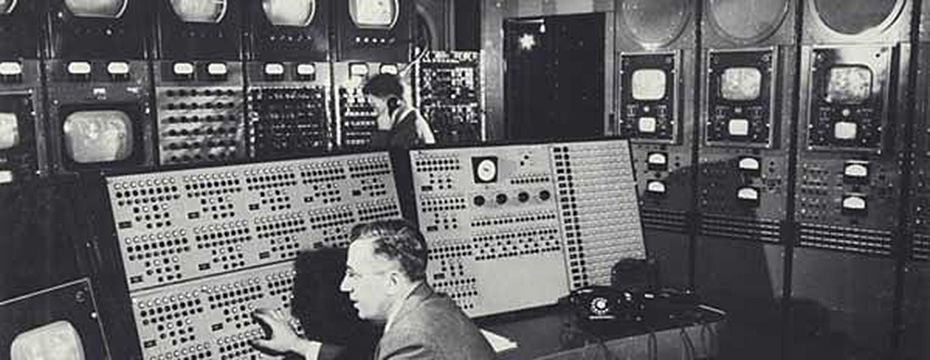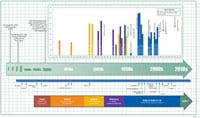
The Story of Television
Published Dec 28, 2012 on YouTube
The story of television history is an interesting one. The Radio Corporation of America (RCA) traces scientific advances related the development of television from the 1920’s to 1950’s, including the introduction of color broadcasts. The film includes technical examples of how televisions work, and notable broadcasts from TV’s early days.
The film is very much a professionally produced promotional showpiece for advances made by RCA, glossing over or omitting details of competing television standards from other manufacturers. As with a lot of the early marketing materials on TV, this peace is clearly being acted to a script. But then, aren’t they all?
On the subject of Television, Wikipedia shares with us:
Television (TV) is a telecommunicationmedium that is used for transmitting and receiving moving images and sound. Television can transmit images that are monochrome (black-and-white), in color, or in three dimensions of either of the prior. The word television comes from Ancient Greek τῆλε (tèle), meaning “far”, and Latinvisio, meaning “sight”. Television may also refer specifically to a television set, television program, or television transmission.
First commercially available in very crude form on an experimental basis in the late 1920s, then popularized in greatly improved form shortly after World War II, the television set has become commonplace in homes, businesses, and institutions, particularly as a vehicle for entertainment, advertising, and news. During the 1950s, television became the primary medium for molding public opinion.. In the mid-1960s, color broadcasting and sales of color television sets surged in the US and began in most other developed countries.
The availability of storage media such as video cassettes (mid-1970s), laserdiscs (1978), DVDs (1997), and high-definition Blu-ray Discs (2006) enabled viewers to use the television set to watch recorded material such as movies and broadcast material. Internet television has seen the rise of television programming available via the Internet through services such as iPlayer, Hulu, and Netflix.
In 2009, 78% of the world’s households owned at least one television set, an increase of 5% from 2003. The replacement of bulky, high-voltage cathode ray tube (CRT) screen displays with compact, energy-efficient, flat-panel alternatives such as LCDs (both fluorescent-backlit and LED-backlit), plasma displays, and OLED displays was a major hardware revolution that began penetrating the consumer computer monitor market in the late 1990s and soon spread to TV sets. In 2013, 87% of televisions sold had color LCD screens.
The most common usage of television is for broadcast television, which is modeled on the radio broadcasting systems developed in the 1920s. Broadcast television uses high-powered radio-frequency transmitters to broadcast the television signal to individual television receivers. The broadcast television system is typically disseminated via radio transmissions on designated channels in the 54–890 MHzfrequency band. Signals are often transmitted with stereo or surround sound in many countries. Until the 2000s, broadcast television programs were generally transmitted as ananalog television signal, but over the course of the following decade, several countries went almost exclusively digital.[citation needed] In addition to over-the-air transmission, television signals are also distributed by cable and satellite systems.
A standard television set comprises multiple internal electronic circuits, including circuits for receiving and decoding broadcast signals. A visual display device which lacks a tuner is properly called avideo monitor rather than a television. A television system may use different technical standards such as digital television (DTV) and high-definition television (HDTV). Television systems are also used for surveillance, industrial process control, and the guidance of weapons in places where direct observation is difficult or dangerous.
A 2004 study by the Children’s Hospital and Regional Medical Center in Seattle, Washington, found a link between infant exposure to television and ADHD.”
Woah, hold the phone. As one who was bombarded by television as a small child, I have to stop the presses and ponder on that last statement. I was placed in front of our television as my mother’s baby sitter for most of the day while my mother tended to other things. I am seriously ADHD. Is there a connection? Certainly something we all need to look into further, but let’s say for a moment this Children’s Hospital finding is correct. If that is the case, then it stands to reason that there should be the same connection with today’s Television equivalents, computers, smartphones, tablet PC’s, and other “alternative” viewing devices.
I believe there mite possibly be. For this hypothesis to be proven true. one of the many criteria that would apply is that there should be a correlation between the rise of cellular and mobile connected devices with a rise in early onset childhood ADHD. According to the CDC (United States Centers For Disease Control and Prevention):http://www.cdc.gov/ncbddd/adhd/data.html
“In the United States:
- The American Psychiatric Association states in the Diagnostic and Statistical Manual of Mental Disorders (DSM-5) that 5% of children have ADHD1. However, studies in the US have estimated higher rates in community samples.
- ADHD Throughout the Years
- The percent of children estimated to have ADHD has changed over time. A historical view provides the necessary context to understand changes in what we know about ADHD, including estimates of the rates of ADHD across time, changes in diagnostic criteria, and medication treatment.
- Recent surveys asked parents whether their child received an ADHD diagnosis from a health care provider. The results show that:
[Read Summary]
- Approximately 11% of children 4-17 years of age (6.4 million) have been diagnosed with ADHD as of 2011.
- The percentage of children with an ADHD diagnosis continues to increase, from 7.8% in 2003 to 9.5% in 2007 and to 11.0% in 2011.
- Rates of ADHD diagnosis increased an average of 3% per year from 1997 to 2006 [Read article] and an average of approximately 5% per year from 2003 to 2011.
- Boys (13.2%) were more likely than girls (5.6%) to have ever been diagnosed with ADHD.
- The average age of ADHD diagnosis was 7 years of age, but children reported by their parents as having more severe ADHD were diagnosed earlier.
- Prevalence of ADHD diagnosis varied substantially by state, from a low of 5.6% in Nevada to a high of 18.7% in Kentucky.”
Clearly, there is a correlation. Whether one is causing the other though, is still subject for debate.
A search for other information on the side effects from the study of other art forms on ADHD in children finds little to no information. Much more work needs to be done in this field. My digging did turn up two other things that seem to help.
Nature
Children who spend time outdoors in natural settings, such as parks, seem to display fewer symptoms of ADHD, which has been dubbed “Green Therapy”
Art Therapy
Art is thought by some to be an effective therapy for some of the symptoms of ADHD. I am a member of this group. Like outdoor physical experiences and Martial Arts practice, all of the arts are subject to the 10,000 hour rule that states “Te become proficient in the arts at more than the most basic of levels requires an investment in excess of ten thousand hours practicing and honing that art’s associated craft skills.
PLEASE RATE THIS STORY! [ratings]
.






